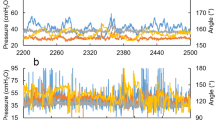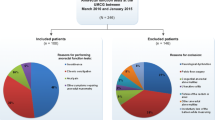Abstract
PURPOSE: The first awareness of balloon inflation (first sensation (FS)), flatus sensation (constant sensation (CS)), urge to defecate (UD), and maximum tolerated threshold (MTT) are the four commonly evaluated rectal sensations. The traditional view that these sensations are attributable to pelvic floor mechanoreceptor stimulation is challenged by current evidence in favor of rectal wall mechanoreceptors. The aim of this study was to determine the physiology of these sensations, using a dynamic mathematic model of the rectum. METHODS: In a group of 15 healthy adult volunteers (11 female and 4 male; median age, 51.5 (range, 31–74) years), the polynomial behavior of the two smooth muscle components of a dynamic mathematic model of the rectum was analyzed to find strain levels of smooth muscle activity in relation to corresponding strain levels of each of the four “rectal” sensations. RESULTS: Longitudinal and circular smooth muscle relaxation appeared to be the rate detection and signaling mechanisms, respectively. The latter triggered sensations of CS, UD, and MTT. FS was an anal canal sensation, related temporally with onset of rectoanal inhibitory reflex.In vitro validation of the model suggested MTT to be a physiologic protective mechanism associated probably with tetanic smooth muscle contraction. CONCLUSIONS: Evaluation of rectal sensations should be confined to CS and UD because MTT is painful and does not contribute any additional information, and FS is not a true rectal phenomenon.
Similar content being viewed by others
References
Goligher JC, Hughes ES. Sensibility of the rectum and colon: its role in the mechanism of anal continence. Lancet 1951;1:543–8.
Scharli AF, Kiesewetter WB. Defecation and continence: some new concepts. Dis Colon Rectum 1970;13:81–107.
Sun WM, Read NW, Prior A, Daly JA, Cheah SK, Grundy D. Sensory and motor responses to rectal distention vary according to rate and pattern of balloon inflation. Gastroenterology 1990;99:1008–15.
Broens PM, Penninckx FM, Lestar B, Kerremans RP. The trigger for rectal filling sensation. Int J Colorectal Dis 1994;9:1–4.
Arhan P, Faverdin C, Persoz B,et al. Relationship between viscoelastic properties of the rectum and anal pressure in man. J Appl Physiol 1976;41:677–82.
Kondo A, Susset JG. Physical properties of the urinary detrusor muscle. J Biomechanics 1973;6:141–51.
Watters DA, Smith AN, Eastwood MA, Anderson KC, Elton RA. Mechanical properties of the rat colon: the effect of age, sex and different conditions of storage. Q J Exp Physiol 1985;70:151–62.
Fung YC. Elasticity of soft tissues in simple elongation. Am J Physiol 1967;213:1532–43.
Akervall S, Fasth S, Nordgren S, Oresland T, Hulten L. Rectal reservoir and sensory function studied by graded isobaric distension in normal man. Gut 1989;30:496–502.
Sun WM, Read NW, Miner PB. Relation between rectal sensation and anal function in normal subjects and patients with faecal incontinence. Gut 1990;31:1056–61.
Alstrup NI, Skjoldbye B, Rasmussen ØO, Christensen NE, Christiansen J. Rectal compliance determined by rectal endosonography: a new application of endosonography. Dis Colon Rectum 1995;38:32–6.
Dall FH, Jorgensen CS, Houe D, Gregersen H, Djurhuus JC. Biomechanical wall properties of the human rectum: a study with impedance planimetry. Gut 1993;34:1581–6.
Dall FH, Jorgensen CS, Djurhuus JC, Gregersen H. Biomechanical wall properties of the porcine rectum: a study using impedance planimetry. Dig Dis 1991;9:347–53.
Gregersen H, Andersen MB. Impedance measuring system for quantification of cross-sectional area in the gastrointestinal tract. Med Biol Eng Comput 1991;29:108–10.
Gregersen H, Stodkilde-Jorgensen H, Djurhuus JC, Mortensen SO. The four-electrode impedance technique: a method for investigation of compliance in luminal organs. Clin Phys Physiol Meas 1988;9:61–4.
Gregersen H, Jorgensen CS, Dall FH. Biomechanical wall properties in the isolated perfused porcine duodenum: an experimental study using impedance planimetry. J Gastrointest Motility 1992;4:125–35.
Gregersen H, Kraglund K, Djurhuus JC. Variations in duodenal cross-sectional area during the interdigestive migrating motility complex. Am J Physiol 1990;259(1 Pt 1):G26–31.
Gregerson H, Orvar K, Christensen J. Biomechanical properties of duodenal wall and duodenal tone during phase I and phase II of the MMC. Am J Physiol 1992;263:G795–801.
Author information
Authors and Affiliations
Additional information
Read at the meetings of the European Society of Surgical Research, Southampton, United Kingdom, March 31 to April 3, 1996, and the International Society of University Colon and Rectal Surgeons, Lisbon, Portugal, April 13 to April 18, 1996.
About this article
Cite this article
Rao, G.N., Drew, P.J., Monson, J.R.T. et al. Physiology of rectal sensations. Dis Colon Rectum 40, 298–306 (1997). https://doi.org/10.1007/BF02050419
Issue Date:
DOI: https://doi.org/10.1007/BF02050419




